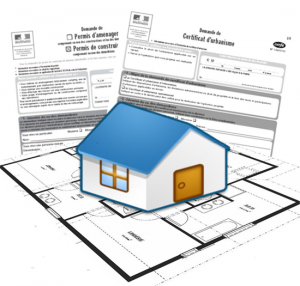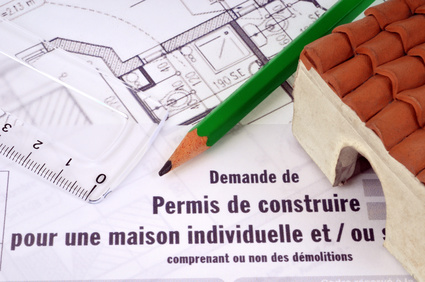Building in France – Planning Application

Certificat d’urbanisme
– Outline planning permission ‘in principal’
The Certificate d’Urbanism is a document which gives details of the planning rules that apply in a given area and tells the applicant whether or not a building project is feasible.
There are two categories to the Certificate d’Urbanisme:- Le Certificat d’Urbanisme d’Information and Le Certificat d’Urbanisme Opérationnel.
Le Certificat d’Urbanisme d’Information
As the name suggests, the certificat d’Urbanisme d’Information, is simply a request for information regarding the current planning status of an existing building or land. It will tell the applicant whether the building concerned is classed as habitation / agricultural/business premises etc. Or in the case of land, whether or not the land is zoned for building and provides information on:-
- The planning provisions, the right to build on the land and under what conditions (eg. rules of a local development plan)
- Administrative limitations (eg. Historical Monuments, Protected Zone etc;)
- The list of taxes and servitude of public utilities.
Le Certificat d’Urbanisme Opérationnel
Certificat d’Urbanisme Opérationnel is a request for an operational planning certificate. It states, in addition to information provided by the Cetificat d’Information, whether, in theory, the land/building can be used for a specific project and the state of public infrastructure (roads and utilities) existing or planned that serve or will serve this plot of land or building.
Information needed for your Dossier
- Cerfa n°13410*03 – Demande de Certificat d’Urbanisme completed
- Plan Cadastral 1:2000/1000
- A written submission explaining the project
Lack of information or supporting documents will delay the processing time. It is therefore important to check with the Mairie to ensure you have included all the documentation necessary to support your application.
Two copies of the application (Demande de Cetificat d’Urbanisme) must be provided for the CU d’Information and four copies for the CU Opérational. These must be sent to the Mairie by Lettre Recommandé avec accusé de réception.
Response time
- 1 month for CU d’information applications;
- 2 months for CU Opérational requests.
If no response is received within this period, the CU will be deemed to be granted tacitly, although to be on the safe side it is advisable to check with the Mairie.
Validity and extension
The Certificate d’Urbanisme is valid for 18 months from receipt.
The validity of the Certificate may be extended by periods of one year as long as the planning requirements, public utility, rights of way, applicable taxes and urban interests in land have not changed.
A request to extend the certificates validity must be made by letter on plain paper in duplicate together with the existing certificate, and sent to the mayor of the municipality where the land/building is located. This application must be submitted at least 2 months before the expiry date of the current CU.
Important Note:
A Certificat d’Urbanisme, is not permission for the realization of a project but is only approval ‘in principal’ and work cannot commence until a Permis de Construire has been applied for and full planning permission has been received.
This certificate also does not guarantee that full planning consent will be granted.
Permis de Construire

A Permis de Construire will be required for any new construction (with certain specific exceptions). If the proposed new dwelling is to have a habitable area of more than 170m2 then an architect must be instructed to prepare the plans and to apply for the consent.
In terms of works to an existing building, unless the work is maintenance or repair the following will generally require a Permis de Construire:
- An extension which increases the existing building by more than 20m²;
- If the building is located in an urban area of a town with a local development plan (PLU) or a land use plan (POS), a permit is required if: adding an extension with a floor area or footprint greater than 40 m; or adding between 20 and 40 m² of floor area or footprint if it increases the total area of the building beyond 170 sqm.
- Works affecting load bearing walls or the external appearance of a building where such works involve a change of use e.g. from a dwelling to a hotel or from an agricultural building to a dwelling;
- Restoration works to an existing building.
Permission to develop the Permis d’Aménager is required when two or more new dwellings are being proposed, where road access or communal spaces are being created, or where the proposed development is within a protected area. If in doubt as to whether this specific type of consent is required or not, you should check with the Mairie.
Information needed for your Dossier
The number of copies of the application form depends on where the property/land is situated for instance if the property is within a conservation zone extra copies of the application and suporting documents will be required.
Along with a plan cadastral showing where the property/plot of land is situated in the commune several other supporting documents will be required. These again depend on the nature of the developement and where the property or land is situated. Full information regarding the documentation needed can be found on the French Government’s website.
This can also be confirmed with the Mairie of the commune, who can also supply the correct forms to fill in and provide a list of the covering information needed to complete the Dossier.
The Dossier must be delivered to the Mairie (either by hand or by Lettre Recommandée Avec Avis de Réception), who will then issue a registration number and a date by which you should receive a response. This will usually be 3 months after submitting the application, but in certain areas (if you are situated near a Historical Monument or a Parc National for example) It can take up to six months. The staff at the Mairie will inform you of this when you deliver your Dossier.
Permis modificatif (permis de construire ou d’aménager)
If during the course of work it is decided that a change is necessary, ie. the fitting of another window or similar, then a Permis Modificatif must be submitted and approval received before these changes are included in the building works.
As above the number of applications and supporting documents required will depend on where the land/property is situated.
Déclaration Préalable
 For minor works a Permis de Construire is not normally required a declaration of intended works – a Déclaration Préalable – will suffice.
For minor works a Permis de Construire is not normally required a declaration of intended works – a Déclaration Préalable – will suffice.
The Déclaration Préalable enables the planning authorities to ensure that the proposed works comply with the planning regulations.
There is no legal obligation to employ the services of an architect to submit a Déclaration Préalable.
Some examples of projects for which a Déclaration Préalable can be used:
- An extension to an existing building which creates a new floor area of more than 5m² but not greater than 20m² (or 40m² in the urban zone of a PLU- Plan Local d’Urbanisme);
- If you are constructing a new building (e.g. a garden shed or workshop), the Déclaration Préable can be used if the floor area created is more than 5m² but no more than 20m² (as long as the building is no more than 12m high! – larger projects will need a Permis de Construire);
- The change of use of an existing building from, for example, agricultural to living accommodation;
- Attic conversions (although some require planning permission eg. If there is no existing staircase )
- Changes to the exterior of the property ie. replacement of a window or door of a different type, making an opening for a new window etc.;
- An uncovered swimming pool which is no larger than 100m²;
- A new boundary wall or fence 2m or higher;
Information required to complete your Dossier
Along with the completed form in duplicate, 2 copies of the following will be required;
- Plan Cadastral 1:2000/1000
- Drawings of the existing and proposed changes (depending on the application)
- A written explanation of the project with photographs
This can be confirmed with the Mairie of the commune, who can also supply the correct forms to fill in and provide a list of the covering information needed to complete the Dossier.
The Dossier must be delivered to the Mairie (either by hand or by Lettre Recommandée Avec Avis de Réception), who will then issue a registration number and a date by which you should receive a response.
This will usually be a month after submitting the application, but in certain areas (if you are situated near a Historical Monument or a Parc National for example) there might be a longer delay. The staff at the Mairie will inform you of this when you deliver your Dossier.
If you haven’t received a negative response to your application by the date indicated, you may commence works – you can ask the Mairie to give you ‘Une attestation de non-opposition à déclaration préalable’ (Certificate of non-opposition to proposed works). You then have two years to complete the works.
Please note:-
Planning regulations do vary from commune to commune so it is important that you visit your Mairie to verify the Plan Local d’Urbanisme (PLU) applicable to your commune.
For instance, areas of historical importance have strict rules regarding the alteration to the exterior of buildings.
Share to: Facebook Twitter LinkedIn Email
More in building in france, certificat de construire, certificate d'urbanism, permis de construire, planning application, planning consent
Leave a reply
Your email address will not be published. Required fields are marked *




REPLY